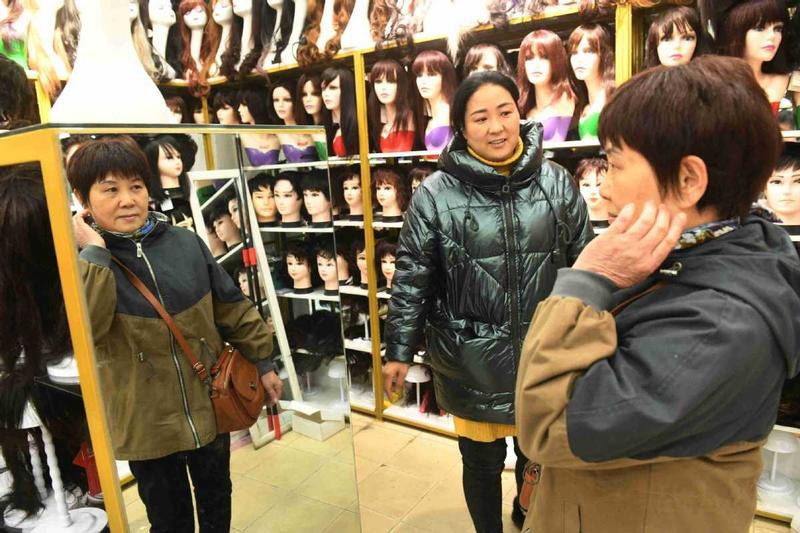 A customer (right) tries on a wig at a store in Fuyang, Anhui province, on Dec 6. (WANG BIAO / CHINA DAILY)
A customer (right) tries on a wig at a store in Fuyang, Anhui province, on Dec 6. (WANG BIAO / CHINA DAILY)
Hair loss has become an increasingly vexing headache for young Chinese consumers, and a niche market has been developing for wig manufacturers.
More than 250 million people in China-or one in every six people-experience some degree of hair loss, and many are under the age of 30, said the National Health Commission.
More than 250 million people in China-or one in every six people-experience some degree of hair loss, and many are under the age of 30, said the National Health Commission
Wigs are one way to deal with the issue, and the wearing of hairpieces has become more popular in the country.
Compared with overseas markets, demand for wigs in China is small but growing. By 2023, sector sales in the country are expected to hit 14.43 billion yuan (US$2.23 billion), according to LeadLeo Research Institute.
"Online shopping has become the main channel for wig purchases in China, especially since the outbreak of COVID-19," said Han Bin, sales director of the domestic e-commerce department at Henan Rebecca Hair Products Co Ltd.
The company said that since the pandemic, online sales of hairpieces in China saw a surge of 60-70 percent compared with pre-pandemic levels as the base number in China is smaller than overseas.
READ MORE: Toying with an idea for the elderly
As of November, sales of wigs on Rebecca's flagship store on Alibaba's Tmall platform surged more than 70 percent year-on-year, though it didn't disclose specific figures.
Rebecca used to be an overwhelmingly export-reliant firm. Fueled by increasing demand for wigs in China, the company has since expanded its business in the domestic market and sales of wigs in the country now make up for more than 20 percent of its total business volume. It plans to continue to raise the proportion of domestic sales, the company said.
"We plan to open more online stores on various e-commerce platforms. We will also increase investments in flagship stores on Tmall and JD and carry out more comprehensive operations. In addition, we plan to cooperate with more social media platforms and key opinion leaders to promote wig products," said Zhang Tianyou, executive deputy general manager at Rebecca.
More than 10 years ago, Rebecca started its e-commerce operations, and it began selling products via livestreaming sessions since 2019.In 2007, Rebecca launched its first wig store in Beijing, and now it has more than 200 stores nationwide. In the next few years, Rebecca said it plans to open more stores nationwide in malls and expand its sales channels and domestic penetration rate.
As China increasingly becomes an aging society, those going gray or experiencing hair loss are growing in number. As hairpieces continue to be better integrated with the hairdressing sector and appear in more barbershops and brick-and-mortar stores, the number of wig consumers in China is expected to continuously expand, LeadLeo said.
In addition, wigs serve a practical purpose in the film industry and in cosmetology schools.
ALSO READ: Anti-hair loss products show growth potential
"In China, wigs carry a relatively high price tag in stores, and their consumers are mainly high-income groups. Women make up about 80 percent of total wig consumers," said Wang Siyu, LeadLeo analyst.
"Consumers' motivation to buy wigs mainly comes from a desire to address thinning or graying hair, and this group accounts for 60 percent of the total. Others wish to wear wigs as a remedy for baldness, and some are willing to wear wigs to become more fashionable and match with different outfits," Wang said.
Rebecca said wig demand started to rebound in May, when the pandemic began to be brought under better control in China. Now, the company has achieved positive sales growth.
Meanwhile, in the past five years, the hair transplant sector in China has been growing at a compound annual growth rate of 20-30 percent, and related technologies have developed fast, said Wu Wenyu, a dermatologist at Huashan Hospital Affiliated to Fudan University in Shanghai.


